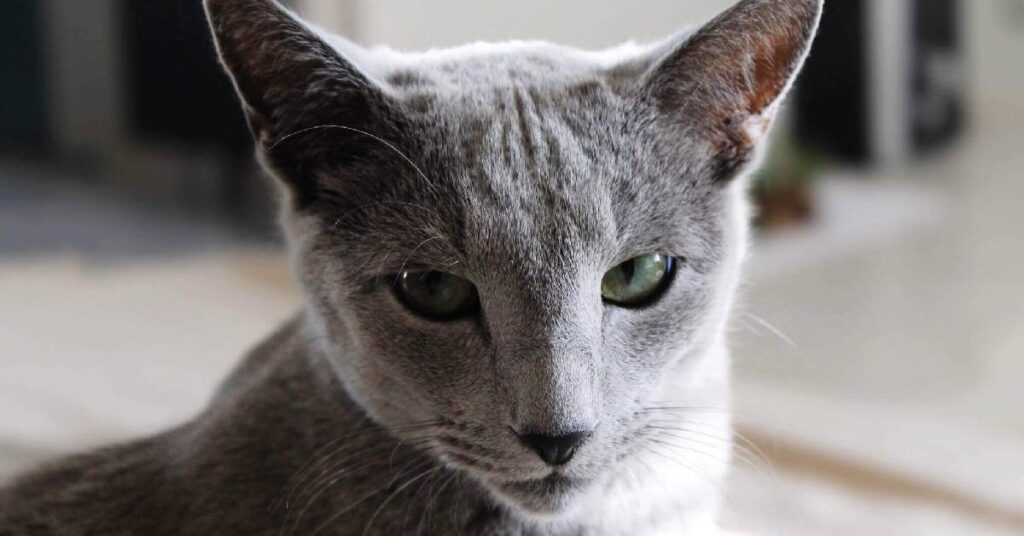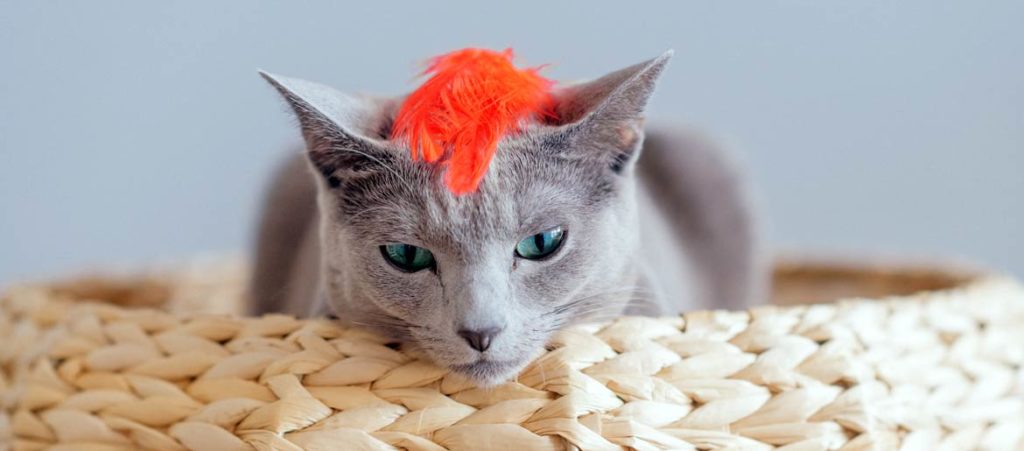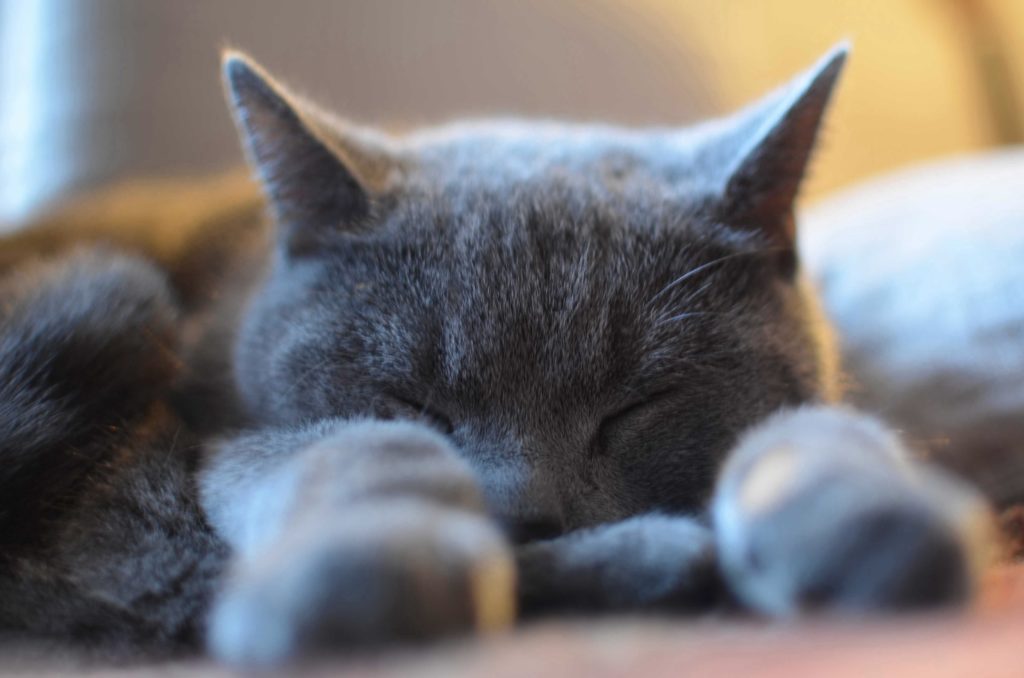Are you considering adopting a Russian Blue cat? One question that might be on your mind is, do Russian Blue Cats shed a lot? After all, nobody wants to deal with constant cat hair on their clothes and furniture.
Allergies can be a real hurdle if you want to keep a pet with furs and sheds, especially if you have severe cat and dog allergies. All in all, shedding feline hair is a big issue for all owners.
When it comes to choosing cats, people look for a breed that is easy to handle and maintain. You know, the kind of pet that you can let in your bed without worrying about their hair being all over the place.
So, do Russian Blue Cats shed a lot? Russian Blue cats do not shed as much as many other cats. They have a dense, plush coat that does not mat easily, and they shed mainly during the shedding season in fall or spring. However, excessive shedding can occur, indicating an underlying health issue or poor grooming habits.
Let us have a look at the coats of the Russian Blue cat and discover if they shed a lot or not in this article.
Do Cats Shed Their Fur?
Yes, cats do shed their fur as part of their natural growth and renewal process. This shedding can occur throughout the year, although it may be more noticeable during seasonal changes, particularly during the spring and fall. Shedding helps cats to get rid of old or damaged fur and make way for new growth.
The amount of shedding can vary depending on the cat’s breed, age, and health. Some cats shed very little, while others shed a lot. Long-haired cats tend to shed more than short-haired cats because they have more hair to lose.
Regular brushing or grooming can help reduce shedding and prevent hairballs, which can be a common issue for cats that shed heavily. If you are concerned about excessive shedding, it is always a good idea to consult a veterinarian to ensure that your cat is healthy and determine if any underlying issues may contribute to the shedding.
Why Do Cats Shed?
Cats are known for their soft and fluffy coats but also regularly shed their fur. Shedding is a natural process that helps cats maintain their coat health and regulate body temperature. Several factors, including seasonal changes in temperature and hormonal fluctuations, influence it.
Cats have a hair growth cycle that involves three phases: anagen, catagen, and telogen. During the anagen phase, hair grows actively from the follicle. In the catagen phase, hair growth slows down, and the follicle shrinks.
Finally, hair is shed from the follicle during the telogen phase, and a new hair growth cycle begins. While shedding is normal, excessive shedding can be a sign of an underlying health condition, such as a nutritional deficiency, stress, or skin irritation.
Is It Normal For Cats To Shed A Lot?
It is normal for cats to shed some fur, but the amount of shedding can vary depending on the breed, age, and health of the cat, as well as other factors such as changes in the environment and seasonal changes. Some cats may shed more than others, and the amount of shedding can also increase during shedding seasons, usually in spring and fall.
Excessive shedding can be a sign of an underlying health issue, such as a skin condition or hormonal imbalance, so it is important to monitor your cat’s shedding patterns and consult with a veterinarian if you notice any unusual changes.
Certain breeds of cats, such as long-haired breeds, may naturally shed more than others, so it is important to groom them regularly to help prevent matting and hairballs.
If you are concerned about your cat’s shedding, it is always a good idea to consult with a veterinarian to ensure that your cat is healthy and to determine if any underlying issues may be contributing to the shedding.
Apart from that, it is not normal when the Russian Blue Cat starts to shed a lot. This is because these cats naturally shed very little as compared to others. You must check and take preventive measures when the Russian Blues shed a lot.
Do Russian Blue Cats Shed A Lot?
No, Russian Blue Cats do not shed a lot compared to other cats. I am not saying that the Russian Blues do not shed at all. Every cat sheds a little no matter what. If they do not, the cat may have health issues. It is also a matter of hygiene and protection.
In general, the shedding period of Russian Blue is actually during the fall and spring. This is the natural shedding period or the seasonal coat changing of the cat. When the cats shed during this season, it regenerates the fur for the winter seasons. The new fur will be thick and keep warm.

Many people assume that Russian Blue Cats shed a lot because they have dense and plush fur that too, with more hairs per square inch than any other cat breed. However, the Russian Blues mostly look big because of their “double coat” fur.
Russian Blue features a double coat of fur, which is more or less flat against the body at a 45-degree angle. Hence, the cat looks larger than it actually is. The undercoat hair of the Russian Blue is, in fact, the same length as their guard hairs.
Why Do Russian Blue Cats Shed Less?
Russian Blue cats have a dense double coat that is shorter than most other breeds. This coat has hair roots that are thicker and shorter, making it difficult for the fur to loosen and fall out.
Russian Blues groom themselves regularly, which helps to distribute natural oils throughout their coat, preventing mats and tangles from forming. This grooming also helps to remove loose fur before it can be shed, resulting in less shedding overall.
The breed’s minimal shedding may also be attributed to its genetics and its origins as a naturally occurring breed in the cold climate of Russia.
But sometimes Russian Blue cats do shed. They shed during certain periods of the year. Know about their shedding more in detail below.
When Do Russian Blue Shed The Most?
Russian Blue cats do not shed much for most of the year. Yet, they experience two seasonal shedding phases every year. These phases take place during the spring and fall seasons.
It is crucial to get ready for these periods. The cat’s coat thins out before spring to adapt to the warmer climate, while in the fall, the coat thickens to cope with the winter weather.
During these times, they may shed their undercoat, which is the thick, soft layer of fur that keeps them warm during colder weather. Shedding the undercoat allows the cat’s skin to breathe and regulate its body temperature as the weather gets warmer.
How Much Do Russian Blue Cats Shed?
Russian Blue cats have a dense, double-layered coat that is known to shed minimally due to its short fur and thick hair roots. This breed is similar to other short-haired breeds, such as Siamese and Bengal cats, in that their shedding patterns are typically minimal.
However, if a Russian Blue cat is mixed with a fluffy cat breed, such as a Maine Coon or Persian, their shedding may be more noticeable.
Healthy Russian Blue cats will not typically leave a lot of hair on their hands or clothing when petting or holding. This is because their silvery fur is shorter than that of other similar breeds, such as the British Shorthair.
While there may be some minimal shedding, it is often difficult to notice with the naked eye. However, using a dark-toothed, slicker brush on your cat may see some ultra-mild shedding.
Medical Issues In Russian Blue Cats That Causes Them To Shed Abnormally
Russian Blue cats are generally a healthy breed, and they do not have any breed-specific medical conditions that cause them to shed abnormally. However, a few medical issues could cause excessive shedding in any cat breed, including Russian Blues.
One possible medical issue that could cause excessive shedding is skin allergies. If a Russian Blue cat is allergic to something in its environment, such as pollen or certain foods, it could experience skin irritation that leads to excessive shedding. Other symptoms of skin allergies in cats include itching, redness, and bumps on the skin.

Another potential medical issue that could cause excessive shedding is hormonal imbalances. Certain hormonal conditions, such as hyperthyroidism or Cushing’s disease, could cause a cat to shed more than normal. In addition to shedding, other symptoms of hormonal imbalances in cats may include weight loss or gain, changes in appetite, and lethargy.
If a Russian Blue cat is shedding excessively, it is important to take them to a veterinarian for a thorough examination. The vet can help determine if an underlying medical issue needs to be treated and can recommend appropriate treatment options to help reduce shedding and improve the cat’s overall health.
How To Reduce Russian Blue To Shed?
Even though you cannot control a lot, you may be able to tame the problem to some limit of your Russian Blue shedding. The cats themselves do much of the work in maintaining their fur.
Sometimes I compare the cat’s grooming routine to my skincare routine. Trust me, they know what they need. Besides that, you should watch out for any drastic changes and some necessary care. Let us examine a few options to reduce the shedding below.
Grooming Routine
Although the Russian Blues have thick coats, the hairs are generally short. Hence, you do not have to groom them every day. Few experts suggest that you should treat the coats at least twice or thrice a week. My suggestion is you should establish a favorable routine and stick to it.
Grooming the Russian Blue not only eliminates dead hair but also distributes skin oils to keep the skin and fur healthy and reduce the shedding in Russian Blue.
It is also important to trim their nails regularly and to clean their ears to prevent infections.
Bath
As I have stated earlier, Russian Blue Cats clean themselves constantly. When you do not find them eating or sleeping, they clean themselves. So, it is not entirely necessary to have them bathed every day. Once a week or twice a week would be nice, though.

In case your cat got filthy, developed parasites, or showed skin diseases, there is no urgency in bathing them.
However, bathing helps to get rid of excess hair. Using a shampoo made for cats when you bathe your cat. Sensitive skin and human shampoos are too hard. Usually, bathing a cat is a two-person activity, so support anyone.
Diet
Health and diet are also important factors that you need to focus on to stop the Russian Blue Cat from shedding a lot. A weak diet invites many allergies and can lead the cat to shed a lot. The four allergies that you can find in cats are insects, contact, inhalant, and food. All these allergies directly have an impact on the skin and fur of your cat.

Insect bites may be allergic to cats as they are to people. Fleabite triggers allergic reactions in cats frequently. An allergy to the inhalant represents one of mold, pollen, and other irritants inhaled by a cat. Eggs, fish, wheat, or beef are the primary causes of food allergies.
The veterinarian has to administer a diet test for 8 to 12 weeks to determine if a cat has a food allergy. The least common form in cats is touch allergy; a physical examination and laboratory testing must be identified.
Check out our other article on Russian Blue Cat Disease, Diagnosis, Treatment, and Prevention, or the Russian Blue Cat Buying Cat.
Spayed or Neutered
Spayed or neutered cats prefer to shed a lot less than cats that are not. The cats are also less likely to develop various forms of cancer if neutered. Likewise, cats, whether Russian Blues or any other, spayed or neutered, are less likely to wander, fight or mark territory.
As cats mature at four months, veterinarians say they should not be neutered after six months. An increased number of veterinarians can alter kittens as young as eight weeks.
Hydration
One of the ways where you can keep your Russian Blues from shedding a lot is hydration. More often than not, cats that do not drink enough water have dry skin and coats that make fur shed. So, ensure you constantly drink clean, fresh, and cool water in a bowl.
Temperament
Russian Blue cats are known for their gentle and affectionate nature. They are intelligent and curious and enjoy interacting with their human companions.
They are also quite sensitive and can be easily stressed by environmental changes. However, with proper socialization and attention, they make excellent pets.
Are Russian Blue Cats Hypoallergenic?
If you are someone who has allergies to pets, then Russian Blue Cats are good pets for you. Yes, the Russian Blue Cats are hypoallergenic. It means these cats have low-shedding fur, less dander, and reduced Fel D 1 protein.
This is the main reason why kitties cause allergic reactions, formed in the cat’s sebaceous glands and saliva.
How Are Allergies Related To Shedding Of Fur In Cats?
Allergies and shedding in cats are related as shedding releases allergens such as dander and saliva, which can cause an allergic reaction in some people.
Russian Blue cats are known for producing less of the Fel d 1 protein, which is associated with allergies, and are therefore less likely to cause allergic reactions in people. This makes them a good choice for those with mild to moderate cat allergies.
While no cat is completely hypoallergenic, the Russian Blue shedding can be minimized with regular grooming and cleaning to reduce the amount of allergens in the environment.
Shedding itself is a normal process that occurs throughout the year and is influenced by seasonal changes in temperature and hormonal fluctuations.
Regular grooming and cleaning can help reduce the number of allergens in a cat’s environment, which can in turn, reduce allergic reactions in sensitive individuals.
Frequently Asked Questions (FAQs)
What Is A Double Coat?
A double coat is a type of coat that is made up of two layers of fur. The undercoat is soft and dense, while the topcoat is longer and coarser. Double coats are common in many dog breeds and some cat breeds, providing insulation and protection from the elements. However, double coats require regular grooming to prevent matting and maintain healthy skin and coats.
Is excessive shedding normal for Russian Blue cats?
No, excessive shedding is not normal for any cat breed, including Russian Blues. While shedding is a regular process that occurs throughout the year, an unusually large amount of hair loss or bald patches can indicate an underlying health issue. Consulting a veterinarian is recommended if excessive shedding is observed.
What are the common causes of shedding in Russian Blue cats?
Russian Blue cats, like all cats, shed due to natural processes such as seasonal changes in temperature and hormonal fluctuations. However, excessive shedding can be caused by stress, poor diet, allergies, parasites, skin irritation, or underlying health conditions. Proper nutrition, grooming, and veterinary care can help minimize shedding.
How to Tell If a Cat Is a Russian Blue?
Russian Blue cats have distinctive features that distinguish them from other breeds. Some of their unique features include a short, dense, and silver-blue coat that is silky to the touch. They also have green eyes that are round and set wide apart, giving them an alert and intelligent expression. Their ears are large, pointed, and set high on their head. They have a medium-sized, muscular body with a long, graceful neck and a wedge-shaped head.
Finally, their paws are small and oval-shaped and have long and tapered tails. Russian Blue cats have a sleek, elegant appearance and a distinctive blue-grey coat.
Conclusion
Russian Blue shedding in a healthy cat is normally light, so brushing it at least once a week should be appropriate. If the cat appears to shed overly, you must probably take it to a veterinarian, particularly when there are signs of ill health, such as loss of hair or constant scratching. If you adopt these precautions regularly, you will not have your Russian Blue Cat shedding a lot.





